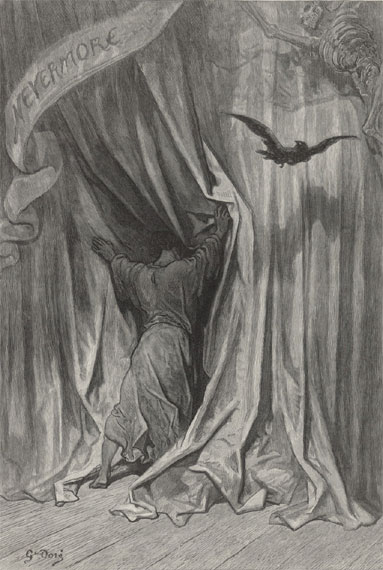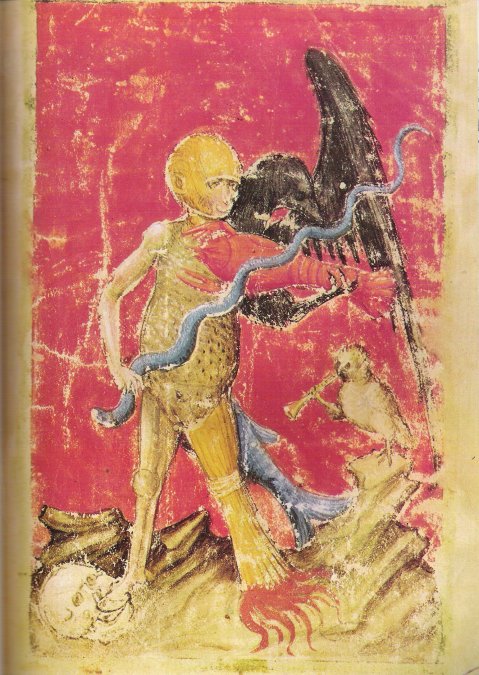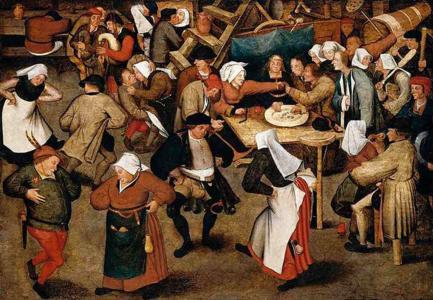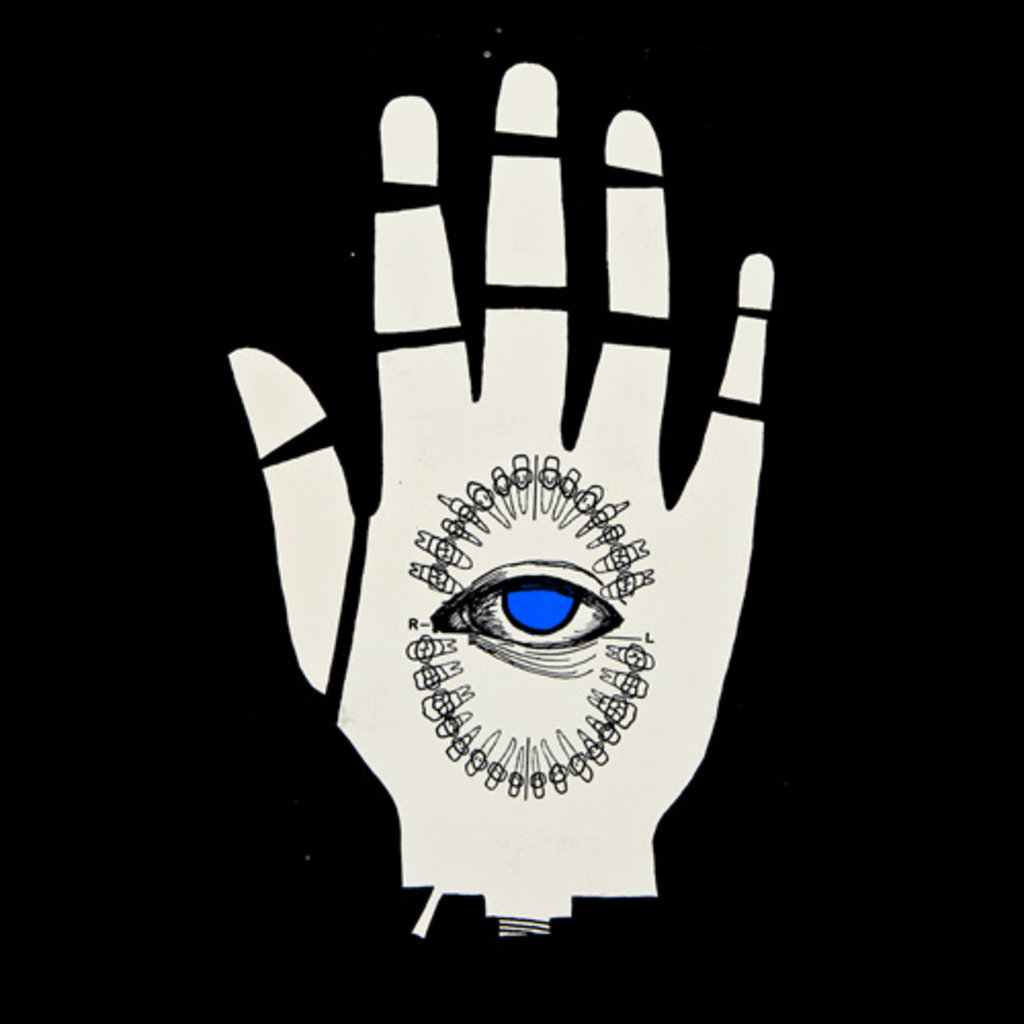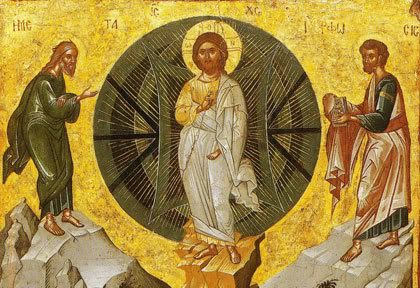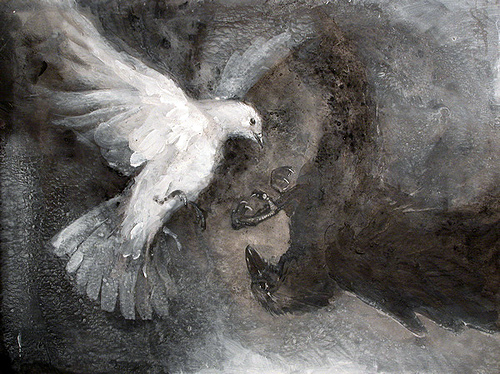"The death of God," in some ways a de-centering of the entire "European" project, opened a multi-perspectived post-ideological worldview able to move "rootlessly" from philosophy to tribal myth, from natural science to Taoism -- able to see for the first time through eyes like some golden insect's, each facet giving a view of an entirely other world.
-- Hakim Bey "The Temporary Autonomous Zone"

The major stumbling block for the paradigm of scientific materialism is human consciousness. Science has very few answers about why and how, from the limited information taken in by the senses, that the mind is able to project outward an entirely coherent holographic reality. That our minds can do this remains a great mystery. An even greater mystery is the inner working of the unconscious, of the creative imagination.
Everything within what we hold to be "reality" is interconnected, if by nothing else than by the mind that perceives it. The mind holds reality together. Even without language, without conscious representational thought, the world exists as a coherent whole. Our mind naturally synthesizes all data that it receives.
Language and symbolic thought, arising through a process of evolution, are simply overlaid on top of this already existing web of context. This is also what allows a small child to learn a language -- the necessary web of context has already been created. It is just a matter of matching the nodes within this web with the words, symbols and concepts of the child's culture. "Clouds" are already related to "sky" in one's mind. For the child it is just a matter of naming them.

This linguistic, naming process has the effect of freezing the various elements of consciousness into general categories, and this can obstruct full understanding, but this is only superficial. The categories themselves are enmeshed in the same webs of context. This is unavoidable. Not even linguistic categories exist in and of themselves.
The scientific method depends on analysis and this it where it falls short in its examination of consciousness. Analysis is fine when attempting to secure facts about physical, tangible things. Here we can assume some semblance, or at least illusion, of "objectivity." When trying to analyse consciousness, though, the process becomes absurd. Consciousness can never isolate itself. There is no "objective" standpoint. Only a feedback loop has been created. The eye cannot see its own act of seeing.

Individual organisms can be observed ostensibly in the act of being conscious, and general conclusions can be made, but really with this we only observe one facet of consciousness. Consciousness has to be explored from within. It is impossible to observe from the outside because observation is also consciousness.
The exploration of consciousness, then, must be subjective. This is not scientific at all. And as all things of this world are really projections of consciousness we can begin to doubt the conclusions of science altogether. Maybe it is only analysing the products of its own imagination? Maybe this analysis itself is directing the course of the phenomena it is analysing? Certainly some interpretations of quantum mechanics seem to point in this direction.
Could the development of science be just one possible ride of the imagination? Is this creative ride merely driven by itself? Is it nowhere nearer to its goal of ultimate understanding than it was when it started? The imagination is infinitely yielding. She will lead us on deeper and deeper to wherever we appear to be headed. She allows patterns to build up from previous patterns. The whole of biological evolution on earth consists of variations on the cell. We are only symphonies of bacteria. But even that is just one story among endless possibilities.

Modern science is utilitarian and practical so it is no surprise that it produces utilitarian and practical results. Technology does not "prove" science . It only demonstrates that certain things and certain effects can be produced by applying a particular method. This does not preclude other methods. It also does not disprove other modes of thinking that have very little emphasis on practicality and utility.
This is not a species of relativism that is being expounded. Nothing is relative because there is no absolute. There is no finality, no ground, by which things can be related or compared. All are fleeting aspects within the ever shifting, centreless web of consciousness. Every mode of thought may succeed according to its own boundaries.
The idea of infinite worlds, as evidenced by the seemingly endless galaxies observed by cosmology, is not confined to modern science. In any system of thought the number of worlds has no limit. There are as many pure lands and hell worlds as there are galaxies. There are as many angels, demons and djinns as there are extra-terrestrial beings.
Scientific understanding may have absorbed and built upon many older systems of thought, but this does not mean these latter were false. It only indicates that they have changed. Just as biological evolution will occasionally go back and advance on atavistic forms so with worldviews the imagination, collective and individual, often returns to prior forms. Imagination has many recessive memes to choose from and activate anew.
Our culture's baseline story must be much broader than it is presently. We cannot, for example, take as a given that we live in an expanding universe about fifteen billion years old that formed out of nothing with a Big Bang. On the face of it this is totally absurd. We also cannot assume that an omnipotent creator made the world in seven days. This is equally absurd, and yet absurdity is not forbidden. Absurd things happen continuously.

It would be even more absurd to say that both of these stories are true at the same time, but the imagination is just this absurd. She is only bound by the codes of logic if she allows herself to be. Both of these stories, and thousands of other myths of creation, are provisionally true. They are also provisionally false. Is the universe expanding or collapsing? Neither one nor the other, nor both, nor neither, nor is the question either meaningful or meaningless.
This then becomes the new baseline. All is infinite, all-powerful imagination. In theory, science accepts that its hypotheses are provisional, but in practice people believe science. It is as much as a religion as anything else. To really free oneself from religion is to free oneself from science.

It is senseless to believe a scientific theory until it is "disproven" a generation later, and then to believe it again when it is "proven" correct once more by the subsequent generation. There is no need to believe at all. The better stance would be to keep all possibilities open at every moment, even the possibility that nothing will ever be definitively proved.
Such a position, however, is certainly harmful to the authority of the scientific establishment. This establishment wants us to follow along with the new discoveries and the new theories just like we follow the most recent celebrity gossip. It wants us to be perpetually fascinated by its cleverness, never to suspect that it may be entirely wrong. It wants us to acknowledge, in light of its discoveries, that the scientific method is the only legitimate means of obtaining true knowledge.

But if the theories of science are so provisional, so subject to change, then why do we not also doubt the supremacy of the method? What knowledge of the world would we uncover outside of the scientific method? What whole worlds open up in unlimited exploration of the imagination?
- Worlds on worlds are rolling ever
- From creation to decay,
- Like the bubbles on a river
- Sparkling, bursting, borne away.
Let us overthrow this epistemological fascism which has obviously so imbalanced both psyche and physis. Science, in its total dominance of the built environment we all live within, is a more straight-jacketed theology than humanity has ever had to endure. It cannot hope to understand what seems to be the most defining aspect of our lives, consciousness, and so we must ask: is it wasting our time?

There is no need to blow up labs or take out whitecoats à la the Unabomber. Quite the contrary. We need to celebrate the benefits that science has provided and the wonders that it has revealed. Science can be plundered for inspiring images and metaphors. Its tools can be used as instruments of creation. But we need to admit its failings and limitations, and to cease believing that it is the exclusive source of truth. There should be no objections to this within science, right? Belief, officially, has no part to play in it.
But what if people by the millions began to explore consciousness, and the worlds it projects, by devising a multiplicity of varied methods and procedures entirely unlike the scientific method? What if people totally bypassed the scientific establishment and its host of expert interpreters and cheerleaders, and began to compile their own results using their own methods?

What if there was a smorgasbord of epistemologies? Would the scientific establishment and its publicists take it in stride? Would they laugh it off in their sage-like humility and continue on with their great work? Or would they be alarmed to their core? Would they complain bitterly about "superstition" and "magic" and "a new dark age" and "the demon-haunted world"? Aren't they already doing this?
This is what terrifies the new orders of priests most of all. It is what, for millennia, has always shaken the Brahmanic castes of all empires: What if individuals, what if the masses, went out actively to find their own truths? What if they accepted no mediation -- no priests, no dogmas, no experts, no scientists, no holy scriptures, no ten commandments, no laws of nature? What if this happened in an almost infinite number of directions -- each exploring paths that sometimes meet and run alongside others and then diverge again?

But there would be chaos, the experts cry. To reject the scientific method is to reject reason, they say. But reason, for much of modern society providing a foundation in the assumed absence of God, itself has no true authority. How do we know, or what makes us think, that what is reasonable is true? We have no way of answering this question. It is as much a myth as any other.
Reason is also only a small facet of the imagination. Reason tries to convince all to follow its laws and tries to forget that it made them up out of nothing. Reason is a very small thing -- a self-conceited cock that crows at the dawn. But the sun would rise whether it crowed or not. Or maybe it would not rise.


